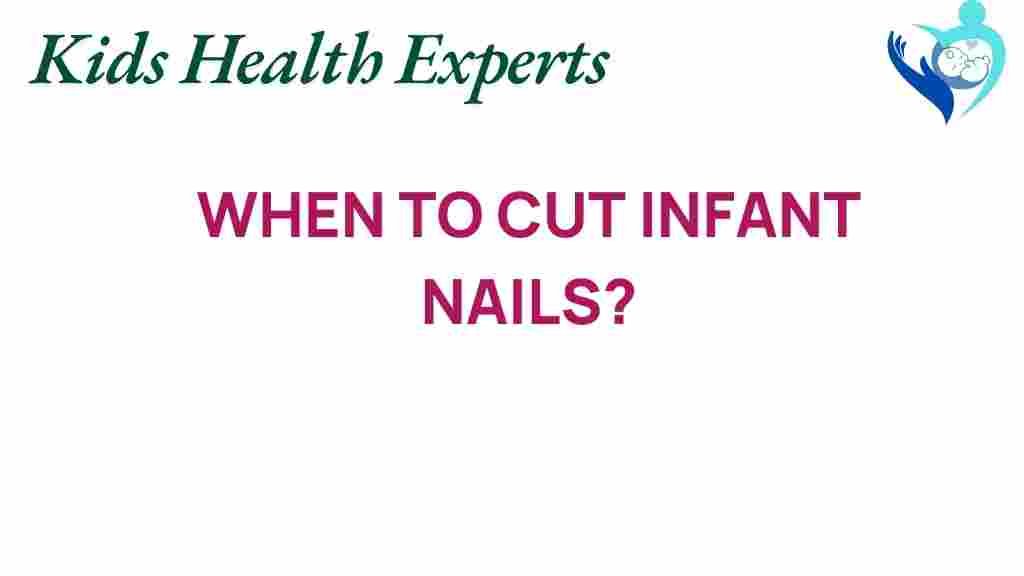The Right Time to Trim Infant Nails: A Guide for New Parents
As new parents, navigating the world of infant care can feel overwhelming, especially when it comes to essential grooming tasks like nail trimming. Keeping your baby’s nails trimmed is crucial for their health and safety. In this guide, we will explore the best practices for trimming infant nails, including when to do it, the tools you need, and tips to make the process easier for both you and your little one.
Why Nail Trimming is Important in Infant Care
Infants are naturally curious and often explore their surroundings with their hands. As they grow, their nails can become sharp, posing a risk of accidental scratches to themselves or others. Here are some reasons why nail trimming is a vital aspect of infant care:
- Prevent Scratches: Sharp nails can easily scratch your baby’s delicate skin or yours during cuddles.
- Health Safety: Long nails can harbor dirt and bacteria, increasing the risk of infections.
- Comfort: Keeping nails trimmed can help prevent discomfort for your baby as they start to explore and play.
When Should You Start Trimming Your Infant’s Nails?
Many new parents wonder when to start with nail trimming. The right time to trim your infant’s nails is typically within the first few weeks after birth. Here are some signs that indicate it’s time for a trim:
- Your baby’s nails have grown long enough to touch their skin.
- You notice scratches on your baby’s face or body.
- Your baby is showing signs of irritation due to their nails.
Tools You Need for Nail Trimming
Having the right tools can make nail trimming easier and safer. Here are some recommended tools for baby grooming:
- Baby Nail Clippers: Specially designed clippers with rounded edges help prevent accidental cuts.
- Nail Scissors: Small, curved scissors can be easier to maneuver around tiny fingers.
- Emery Board: A soft emery board can smooth any sharp edges after trimming.
- Good Lighting: Ensure you have adequate lighting to clearly see your baby’s nails.
- A Comfortable Position: Hold your baby securely in your lap or on a flat surface.
Step-by-Step Process of Trimming Infant Nails
Now that you have the right tools, follow this step-by-step process for trimming your infant’s nails safely:
- Choose the Right Time: Pick a time when your baby is calm, such as after a nap or feeding.
- Get Comfortable: Sit in a well-lit area, holding your baby securely on your lap or on a safe surface.
- Hold the Hand Steady: Gently hold your baby’s hand and press the fingertip to extend the nail.
- Trim Carefully: Using the clippers or scissors, trim the nail straight across, avoiding the skin.
- Smooth Edges: Use an emery board to smooth any sharp edges if needed.
- Repeat with Each Finger: Move on to the next finger and repeat the process.
- Trim Toenails Sparingly: Toenails don’t need to be trimmed as often; check them every few weeks.
Tips for Successful Nail Trimming
Here are some helpful parenting tips to make nail trimming a more enjoyable experience:
- Distract Your Baby: Use toys or sing to your baby to keep them calm during the process.
- Involve a Partner: Having another adult to help can make the process smoother.
- Be Patient: If your baby becomes upset, take a break and try again later.
- Establish a Routine: Incorporate nail trimming into your baby grooming routine to make it a familiar practice.
Troubleshooting Common Issues
Despite your best efforts, you may encounter some challenges while trimming your infant’s nails. Here are some common issues and how to deal with them:
1. Your Baby Is Fidgeting
If your baby is squirming or fidgeting, try the following:
- Take a break and wait until they are more settled.
- Use a soothing voice or engage them with a toy.
2. Accidental Cuts
It’s common for accidents to happen. If you accidentally cut the skin:
- Apply gentle pressure with a clean cloth.
- Use a bit of antiseptic if necessary.
- If bleeding persists, consult a pediatrician.
3. Your Baby Hates the Process
If your infant dislikes nail trimming:
- Try trimming their nails while they are asleep.
- Make it a fun activity by letting them play with the clippers (under supervision).
Maintaining Nail Health
In addition to trimming, it’s essential to maintain your baby’s nail health. Here are some tips:
- Regular Checks: Check your baby’s nails weekly for growth and dirt.
- Keep Them Clean: Wash your baby’s hands and nails regularly to prevent any build-up of dirt.
- Moisturize: If your baby’s skin around the nails is dry, consider using a gentle moisturizer.
When to Seek Professional Help
While most nail trimming can be done at home, there are instances where you should consult a professional:
- If your baby has ingrown nails.
- Frequent infections or redness around the nails.
- If you are uncomfortable or unsure about trimming nails.
Conclusion
Nail trimming is an essential aspect of infant care that contributes to your baby’s health and safety. By following the steps outlined in this guide, you can ensure that the process is safe and efficient. Remember to be patient and gentle, as establishing a positive experience will make future grooming sessions easier. For more parenting tips and resources, check out this helpful guide from an expert in infant care.
As you embark on this parenting journey, remember that every little task, including nail trimming, is a step toward providing the best care for your baby. Happy grooming!
For additional information on infant grooming techniques, visit this external resource.
This article is in the category Care and created by KidsHealthExperts Team
